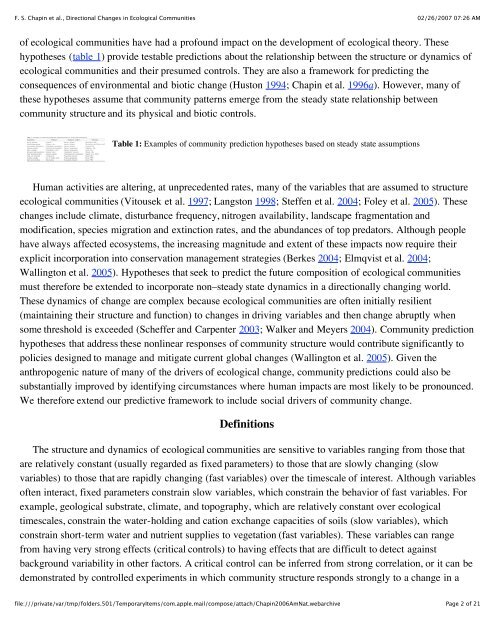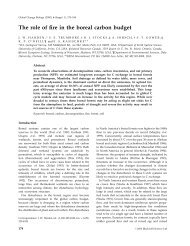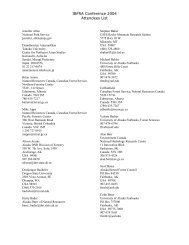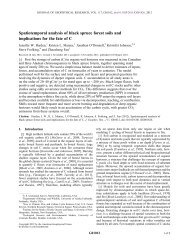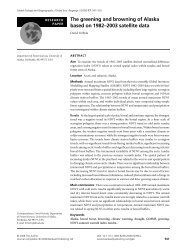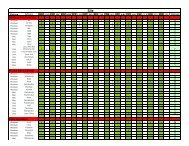Chapin, F.S., III, M.D. Robards, H.P. Huntington, J.F. Johnstone, S.F. ...
Chapin, F.S., III, M.D. Robards, H.P. Huntington, J.F. Johnstone, S.F. ...
Chapin, F.S., III, M.D. Robards, H.P. Huntington, J.F. Johnstone, S.F. ...
You also want an ePaper? Increase the reach of your titles
YUMPU automatically turns print PDFs into web optimized ePapers that Google loves.
F. S. <strong>Chapin</strong> et al., Directional Changes in Ecological Communities<br />
02/26/2007 07:26 AM<br />
of ecological communities have had a profound impact on the development of ecological theory. These<br />
hypotheses (table 1) provide testable predictions about the relationship between the structure or dynamics of<br />
ecological communities and their presumed controls. They are also a framework for predicting the<br />
consequences of environmental and biotic change (Huston 1994; <strong>Chapin</strong> et al. 1996a). However, many of<br />
these hypotheses assume that community patterns emerge from the steady state relationship between<br />
community structure and its physical and biotic controls.<br />
Table 1: Examples of community prediction hypotheses based on steady state assumptions<br />
Human activities are altering, at unprecedented rates, many of the variables that are assumed to structure<br />
ecological communities (Vitousek et al. 1997; Langston 1998; Steffen et al. 2004; Foley et al. 2005). These<br />
changes include climate, disturbance frequency, nitrogen availability, landscape fragmentation and<br />
modification, species migration and extinction rates, and the abundances of top predators. Although people<br />
have always affected ecosystems, the increasing magnitude and extent of these impacts now require their<br />
explicit incorporation into conservation management strategies (Berkes 2004; Elmqvist et al. 2004;<br />
Wallington et al. 2005). Hypotheses that seek to predict the future composition of ecological communities<br />
must therefore be extended to incorporate non–steady state dynamics in a directionally changing world.<br />
These dynamics of change are complex because ecological communities are often initially resilient<br />
(maintaining their structure and function) to changes in driving variables and then change abruptly when<br />
some threshold is exceeded (Scheffer and Carpenter 2003; Walker and Meyers 2004). Community prediction<br />
hypotheses that address these nonlinear responses of community structure would contribute significantly to<br />
policies designed to manage and mitigate current global changes (Wallington et al. 2005). Given the<br />
anthropogenic nature of many of the drivers of ecological change, community predictions could also be<br />
substantially improved by identifying circumstances where human impacts are most likely to be pronounced.<br />
We therefore extend our predictive framework to include social drivers of community change.<br />
Definitions<br />
The structure and dynamics of ecological communities are sensitive to variables ranging from those that<br />
are relatively constant (usually regarded as fixed parameters) to those that are slowly changing (slow<br />
variables) to those that are rapidly changing (fast variables) over the timescale of interest. Although variables<br />
often interact, fixed parameters constrain slow variables, which constrain the behavior of fast variables. For<br />
example, geological substrate, climate, and topography, which are relatively constant over ecological<br />
timescales, constrain the water-holding and cation exchange capacities of soils (slow variables), which<br />
constrain short-term water and nutrient supplies to vegetation (fast variables). These variables can range<br />
from having very strong effects (critical controls) to having effects that are difficult to detect against<br />
background variability in other factors. A critical control can be inferred from strong correlation, or it can be<br />
demonstrated by controlled experiments in which community structure responds strongly to a change in a<br />
file:///private/var/tmp/folders.501/TemporaryItems/com.apple.mail/compose/attach/<strong>Chapin</strong>2006AmNat.webarchive<br />
Page 2 of 21


